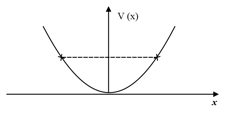The potential energy function for a particle executing linear simple harmonic motion is given by , where is the force constant of the oscillator. For , the graph of versus is shown in Fig. Show that a particle of total energy moving under this potential must ‘turn back’ when it reaches .



Important Points to Remember in Chapter -1 - Work, Energy and Power from NCERT PHYSICS PART 1 TEXTBOOK FOR CLASS XI Solutions
(i) Dot product or scalar product of two vectors and is defined as , where is the angle between and
(ii) and then,
(iii) Work done by a constant force,
(iv) Work done by a variable force
2. Relation between kinetic energy and momentum:
Relation between momentum and kinetic energy, and , where is linear momentum
3. Potential energy:
(i) Potential energy and force are related as, i.e., where is the work done by the conservative force.
(ii) Conservative force can be found from potential energy using the equation,
4. Work energy theorem:
According to work-energy theorem, the net work done on a body is equal to the change in the kinetic energy,
5. Power:
(i) Power is the rate of work done,
(ii) The average power delivered by an agent is given by
(iii) Instantaneous power,
6. Conservation of energy:
(i) According to conservation of mechanical energy, the total mechanical energy of an isolated system is conserved if the internal forces are conservative.
7. Collisions:
(i) The total momentum of a system remains constant during a collision.
(ii) Gravitational force and spring force are always non-impulsive during collision.
(iii) Total energy is conserved in an elastic collision.
(iv) The energy lost is maximum in a perfectly inelastic collision.
(v) The two equations which we can use in a collision are: and .
(vi) is the coefficient of restitution. It is for elastic collision, for perfectly inelastic collision and for inelastic collision it will be between and .
